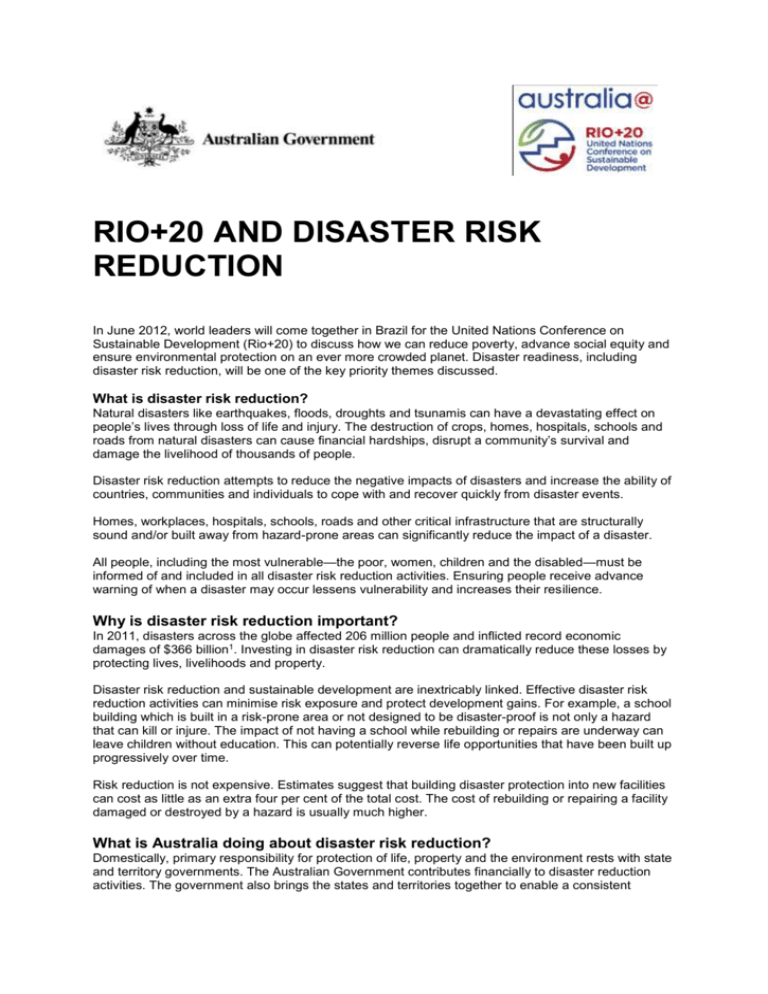Rio+20 and Disaster Risk Reduction factsheet (DOCX
advertisement

RIO+20 AND DISASTER RISK REDUCTION In June 2012, world leaders will come together in Brazil for the United Nations Conference on Sustainable Development (Rio+20) to discuss how we can reduce poverty, advance social equity and ensure environmental protection on an ever more crowded planet. Disaster readiness, including disaster risk reduction, will be one of the key priority themes discussed. What is disaster risk reduction? Natural disasters like earthquakes, floods, droughts and tsunamis can have a devastating effect on people’s lives through loss of life and injury. The destruction of crops, homes, hospitals, schools and roads from natural disasters can cause financial hardships, disrupt a community’s survival and damage the livelihood of thousands of people. Disaster risk reduction attempts to reduce the negative impacts of disasters and increase the ability of countries, communities and individuals to cope with and recover quickly from disaster events. Homes, workplaces, hospitals, schools, roads and other critical infrastructure that are structurally sound and/or built away from hazard-prone areas can significantly reduce the impact of a disaster. All people, including the most vulnerable—the poor, women, children and the disabled—must be informed of and included in all disaster risk reduction activities. Ensuring people receive advance warning of when a disaster may occur lessens vulnerability and increases their resilience. Why is disaster risk reduction important? In 2011, disasters across the globe affected 206 million people and inflicted record economic damages of $366 billion1. Investing in disaster risk reduction can dramatically reduce these losses by protecting lives, livelihoods and property. Disaster risk reduction and sustainable development are inextricably linked. Effective disaster risk reduction activities can minimise risk exposure and protect development gains. For example, a school building which is built in a risk-prone area or not designed to be disaster-proof is not only a hazard that can kill or injure. The impact of not having a school while rebuilding or repairs are underway can leave children without education. This can potentially reverse life opportunities that have been built up progressively over time. Risk reduction is not expensive. Estimates suggest that building disaster protection into new facilities can cost as little as an extra four per cent of the total cost. The cost of rebuilding or repairing a facility damaged or destroyed by a hazard is usually much higher. What is Australia doing about disaster risk reduction? Domestically, primary responsibility for protection of life, property and the environment rests with state and territory governments. The Australian Government contributes financially to disaster reduction activities. The government also brings the states and territories together to enable a consistent approach to prevention and mitigation through such measures as building codes, risk modelling and mapping. Internationally, the Australian aid program is a leading donor in disaster risk reduction. In 2010–11, the Australian Government invested more than $100 million in disaster risk reduction activities in over 64 countries. Some of the activities supported by the Australian Government included: providing education on disaster risks and risk reduction principles collecting and sharing hazard and vulnerability data and risk maps encouraging safe land use planning based on hazard information improving early warning systems and training local people in first aid supporting scientific agencies specialised in hazard and risk reduction addressing reoccurring food shortage issues caused by hazards like droughts and floods assisting countries be better prepared to effectively respond to a disaster ensuring post-disaster reconstruction is based on disaster risk reduction principles. Further Information Further information on disaster risk reduction can be found at http://www.ausaid.gov.au/keyaid/disasterriskreduction.cfm Information about Australia’s emergency management arrangements and the National Strategy for Disaster Resilience can be found at www.em.gov.au Further information on Rio+20 and other Australian Government sustainable development initiatives can be found at www.environment.gov.au/rio or contact us at uncsd2012@environment.gov.au







